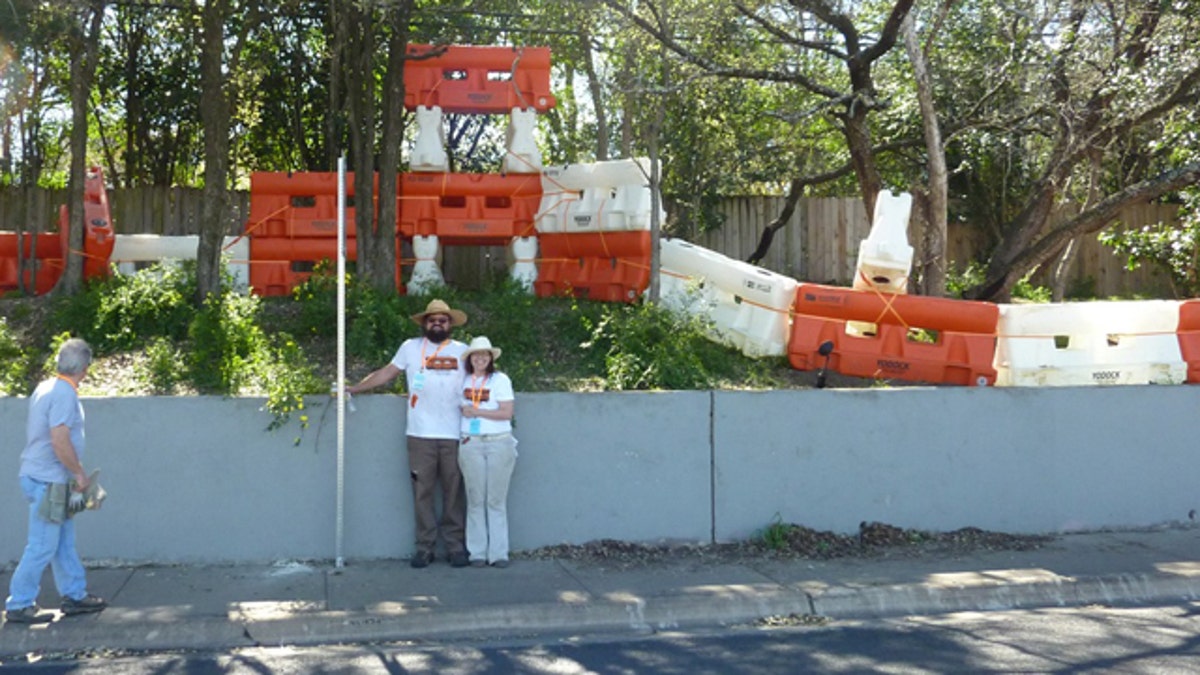
Austin, Texas' cultural arts division is helping sponsor a public installation made up of 50 traffic barriers, an orange-and-white Stonehenge that the project's mastermind is calling the 'Barton Barriers.' (Steve Dubov)
It's dozens of feet long, weighs over 35,000 pounds, lights up at night and cost Austin, Texas, about $4,300 in city funds. But the question remains: Is it art, or a sprawling waste of taxpayer money?
The city's cultural arts division is helping sponsor a public installation made up of 50 traffic barriers — an orange-and-white Stonehenge that the project's mastermind is calling the "Barton Barriers."
"It's lighthearted — there is no deep meaning in it," said Steve Dubov, an Austin-based sculptor who hopes to turn the city into an outdoor museum with his installations. "It's just a very interesting thing and it's supposed to make you smile."
Dubov, who led 58 people in construction efforts this weekend at a busy intersection on the Barton Skyway, said he's transforming something normally seen as a public nuisance into public art.
"These barriers are ubiquitous, generally troublesome, meaning when you see one you know you're about to get squeezed by traffic," he said.
Dubov's team has pitched in over ten thousand dollars and he says he's received grants from the Texas Commission on the Arts, the National Endowment for the Arts and the $4,300 gift from Austin's coffers.
It's not a huge amount of money, but it has contributed yet another chip at the gaping $11 billion budget hole staring the state of Texas in the face.
Now some taxpayer watchdogs are chasing after traffic barriers and snarling at what they see as just another example of city waste in a time of national economic hardship.
"It really makes the citizens wonder if Texas officials get it — if they understand the kind of economic mess they're in," said David Williams, vice president of policy at Citizens Against Government Waste. "They really shouldn't be fiddling while their state budget is burning."
Dubov said the reaction at the site has been overwhelmingly positive, a claim backed up by the city's arts leaders, who said the project is very much worth the investment.
"I think it's a very interesting and worthwhile project," said Vincent Kitch, the cultural arts program manager for the city of Austin, who noted that taxpayers in his city don't have to foot the bill for the project.
"Let's clarify — it's not wasting anyone's tax money," Kitch told FoxNews.com. "The funding that we give out is actually generated from a portion of our hotel-motel tax ... so it's not local tax money that's being spent ... it's the visitors who help pay for this public art."
That was little consolation to tax watchdogs, who noted that Texans and other taxpayers will still be supporting the project whether they like it or not, whenever they spend a night in Austin's hotels.
"There are a lot of Texans paying for this — it's not just the 'outsiders' that are paying for it," said Williams, of Citizens Against Government Waste.
The city's cultural arts division noted that the project has been a success in creating conversation and controversy in Austin, but that conversation hasn't always been too kind.
Some readers who heard about the project from a column in the city's American Statesman newspaper are calling it a bureaucratic bungle that should be taken down.
"There's just no hope for Austin anymore — and I hope they take away the eyesores very quickly!" wrote a reader posting under the name "dewittarar."
But others have piped up in favor of the project, calling it a worthy focus for the city that barely cost residents a penny.
"The collaboration and cooperation required to make the vision a reality makes the entire project worthwhile," said one poster writing under the name BFK. "I volunteered my Saturday and my tax dollars to this project & don't regret a single bit of it."
Whether it's an eyesore or a monument, Dubov defended his piece and said it's helped cleaned up the street, brought together the neighborhood, and shown "all of the earmarks of art."
"Whether it's a masterpiece or will last a millennium," he added, "that's another question."

